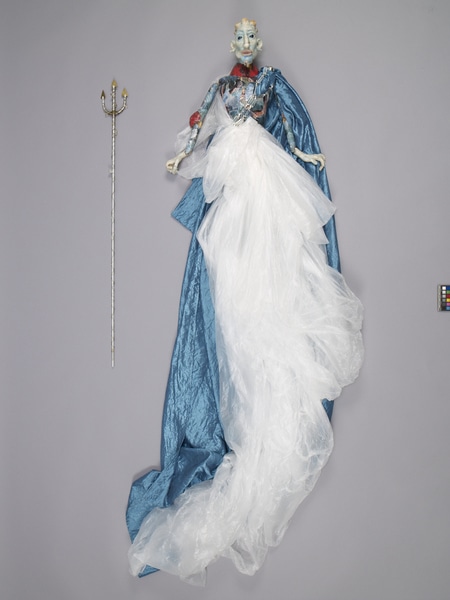Puppet Item Number: 2956/293 a-b from the MOA: University of British Columbia


Description
String puppet (marioneta) of the character Neptune with carved wood face, a pointed beard tipped with a painted shell, pink lips, a long nose, black plastic eyes, sharply defined brow, short forehead and prominent ears. Small shells cover the scalp. A thin wooden stick protrudes from the back of the head and is the only method of controlling the puppet. Puppet’s torso is paper mache. Arms and hands are wood. Torso and arms are covered by decoupage in patterns coloured blue and red, while hands are painted light blue. The creature’s bottom is made entirely of thin, white, flowing plastic sheeting. A long blue cape attaches at the shoulder and hip by a beaded cross-chest belt and falls the length of the plastic bottom. Puppet’s hands and face are delicately carved and detailed. The trident (part b) is aluminum, with a long staff and three pronged head. The whole is wrapped with brass wire, with clear beads threaded on intermittently. Each prong is topped by a gold triangle.
History Of Use
Ten marionettes were made especially by Jorge Cerqueira for the Museum of Anthropology collection (see #2956/293-300 & #3105/1-2). These marionetas (string puppets) represent key characters—historical heroes and gods, sultans and kings, the dangerous storm, Adamastor, and the beautiful goddess, Venus, dressed in crimson—from the Portuguese epic, The Lusiads (1572). Written by the one-eyed adventurer and beloved poet, Luís de Camões, The Lusiads tells of the Portuguese discovery of a sea route to the East. The hero of the fantastical tale is the explorer, Vasco da Gama, who is either aided or opposed on his voyage by the Roman gods: Jupiter, Bacchus, Neptune and Venus. En route, Vasco da Gama’s fleet is welcomed by the Sultan of Malindi (Kenya) and bravely battles Adamastor, the gigantic storm, before arriving in India and meeting Monsayeed, the ruler of Calcutta (now Kolkata). Setting sail again, the Portuguese explorers stop to feast on the Isle of Love and afterwards journey on through the Indian Ocean, visiting parts of Asia and Africa. This character represents Neptune, Roman god of the sea, freshwater, earthquakes, hurricanes, and horses.
Iconographic Meaning
Puppet representing Neptune, the Roman god of the sea, as a character in "Os Lusíadas" (The Lusiads).
Item History
- Made by Jorge Cerqueira (Maker) in Sintra, Lisboa, Portugal during 2012
- Collected by Anthony A. Shelton in Portugal during 2012
- Owned by Anthony A. Shelton before September 17, 2012
- Received from Museum of Anthropology Exhibitions Budget (Funding source) and Anthony A. Shelton (Seller) on September 17, 2012
What
- Name
- Puppet
- Identification Number
- 2956/293 a-b
- Type of Item
- puppet
- Material
- plastic, synthetic fibre, wood, shell, paint, aluminium metal, brass metal, paper and adhesive
- Part B
- height 103.0 cm, width 11.0 cm, depth 2.0 cm
- Overall
- height 226.0 cm, width 27.0 cm, depth 13.5 cm
Who
- Culture
- Portuguese
- Creator
- Jorge Cerqueira (Maker)
- Field Collector
- Anthony A. Shelton
- Previous Owner
- Anthony A. Shelton
- Received from
- Museum of Anthropology Exhibitions Budget (Funding source) and Anthony A. Shelton (Seller)
Where
- Holding Institution
- MOA: University of British Columbia
- Made in
- Sintra, Lisboa, Portugal
- Collected in
- Portugal
When
- Creation Date
- during 2012
- Collection Date
- during 2012
- Ownership Date
- before September 17, 2012
- Acquisition Date
- on September 17, 2012
Other
- Condition
- excellent
- Accession Number
- 2956/0293 a-b